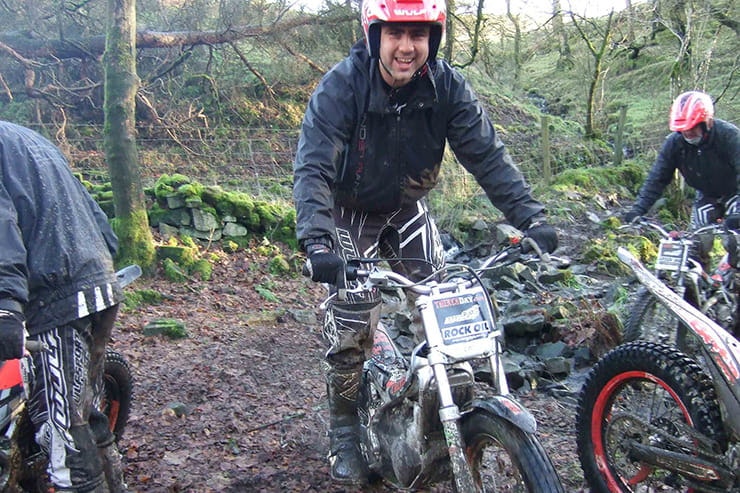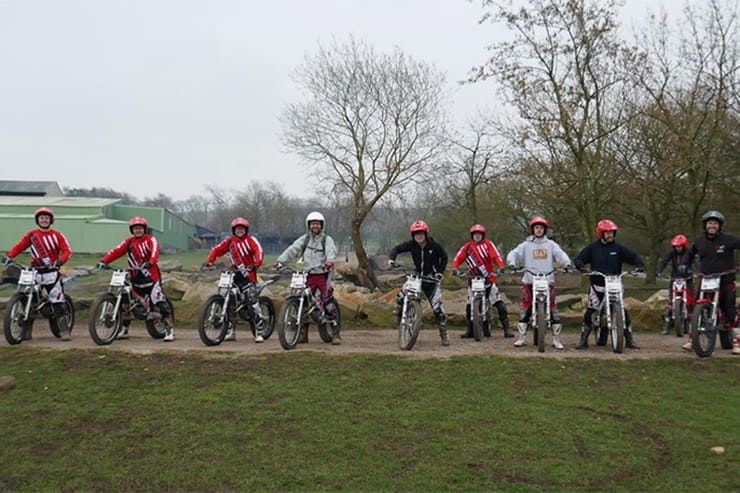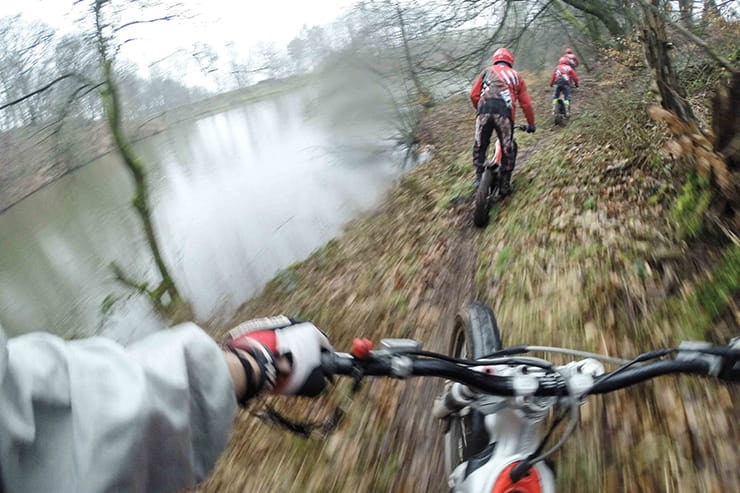From a road rider’s perspective, trials is the weirdest of motorcycling’s weirdy off-shoots. The bikes have no saddles, the tyres have 5psi, and speed usually only happens when you’ve cocked up. It makes speedway seem normal, which is saying something. But it’s no coincidence that so many elite racers – from current WSB front-runner Leon Haslam to ex-World Champ Kevin Schwantz – rave about the benefits trials brings to their tarmac riding.
To see if we could absorb some trials magic, some friends from my local and I booked an ‘Experience Day’ at Trialsday.com. It’s run by Stu Day on his farm near Leek in Derbyshire and promises a structured day of tuition, riding his fleet of Beta bikes (lids, boots etc are provided too). Stu’s been running the school for over a decade and has courses for beginners to experts. We’re all beginners – we’ve ridden road bikes for years, but our trials experience ranges from hardly any to zero. Let’s see what he makes of us.
What you’ll learn
For beginners, the course gives you the basic trials skills – full-lock slow-motion turns, ascending and descending slopes varying from easy to oooo-not-sure-about-that, turns on slopes, riding over small obstacles, braking on dodgy surfaces, finding grip and how to lift the front wheel. The key building block for all these skills is body position, and that’s what Stu concentrates on first. The morning is brilliantly structured, with a dozen or so five minute lessons followed by riding practice – on the flat to start with, then moving up onto Blackshaw Moor as confidence builds and we all start to get the hang of using our feet to steer, relaxing our arms and using the clutch as a precise speed controller. It’s utterly absorbing, bloody difficult and hilarious all at the same time (watching your mates fall into streams, bogs and gorse bushes never stops being funny in my experience). With the foundations laid and a home-cooked pie and chip meal consumed, we spend the afternoon following Stu as he guides us around the moors, demonstrating new techniques and stopping to negotiate increasingly tricky obstacles. There’s no pressure to attempt them, and by mid-afternoon most of us are so exhausted we’re taking the easy routes. There are comedy mud-based falls aplenty, but one of the advantages of trials is that you have to work very hard to seriously damage yourself. If you’re gung-ho, bruises and scrapes are the worst you can expect.
Who’s it aimed at?
Everyone from complete beginners to experienced trials competitors. Stu adapts his courses based on experience, talent, fitness etc – he changed the end of our course because our pub-based training regime meant we were feeling rather tired and thirsty by 3pm.
What I got out of it
Primarily it was great fun. Remember when you were a kid, just dicking about in the road or garden on your pushbike for no other reason that it was a laugh? That’s what trials feels like. You’re just mucking about, seeing what you and the bike can do – having a go at riding over a log, falling on your arse, cursing at your laughing mates, then having another go. The addition of a superb instructor like Stu just means you don’t waste time doing stuff completely wrong and getting frustrated. Plus he pushes you – by the end of the day, all of us were attempting slopes and obstacles that we would never have attempted if Stu didn’t say we’d make it. Ride along a slippery drainage pipe? No thanks. But half of us had a go and we all managed it. The feeling of satisfaction at learning a new skill, putting it into action and succeeding is addictive.
Then there are the actual skills you learn. Stu’s exercises force you to concentrate on exactly what you do with your weight, and the effect that has on the bike. Everyone came away with different revelations; here are my three breakthroughs:
Steer with your weight, then you can relax your arms. Because trials bikes are so light and you’re standing up, if you put all the weight on the left peg, the bike will flop into a left turn. More weight, more turn. As a road rider I’m so used to steering with my arms it took me ages to get this. But once I did, it meant my upper body and arms were relaxed, I could stand up straighter, I was far less tired, my turns were tighter, and the bike tracked over rocks easier (because I was loose). It made life so much easier.
Always let the bike push you, not pull you. Going up steep slopes I tended to bend my legs, which dropped my weight back, which meant I ended up clinging on to the bars as the bike pulled me up the incline. If the slope was steep, or if I gave the bike a handful of throttle, the front wheel would come up and I’d fall off the back. But once I got the hang of letting the bike push me from the footpegs it all became easy – you lean forward, keep your legs straight and with all your weight pushing into the back tyre, up she goes. Plus your arms don’t get exhausted.
When turning, don’t tense your inside shoulder. For any office workers with bad posture like me, this is so easy to fall into. But it stops your upper body rotating with the bars and limits how tightly you can turn. Once I’d dropped the habit of tensing my inside shoulder, turns felt natural and instinctive, rather than a battle. I do this on a road bike too, which leads us to...
How does it relate to road riding?
The most obvious benefit is slow speed control. The techniques we learned about how to make full-lock tight turns transfer easily to road bikes – set your clutch slip, use delicate front brake control to give a smidge of friction, get your body position right, look where you want to go and et voila. And the course gives you confidence too – if you can do tight, slow turns on a wet, steep, grassy slope, a flat car park on a GS suddenly looks rather less intimidating.
For me, there was also a cross-over with relaxation. If you get your body position right on a trials bike, you can be relaxed during the turn, and the bike can do what it’s designed to do. Get it wrong, and you’re tense, and the bike can’t react as it should. When Stu pointed out that my inside arm and shoulder were tense and stopping my rotating my torso, I realised that’s what I was doing in fast corners on a road bike. I tense up, the bike can’t steer properly and starts to push wide. It’s going to take a while to re-train myself, but my road riding will get better thanks to the trials.
Then there’s grip. In trials you think about this all the time – at the front going down hills, and at the rear going up – and you run out of it every 10 seconds. The joy is, because the speeds are so low, nothing too drastic happens. When you lose the front down a muddy slope you might crash into a bush at the bottom because you panicked and let the front brake off, or you might tuck the front and fall into a heap. But you’ll probably get away with it. And so you keep learning what losing grip feels like and you get faster and faster at correcting it. It’s not hard to understand why Kevin Schwantz put his ability to slide both ends of a 500cc GP bike down to trials riding as a kid.
What’s the next step?
If you come away from a day with Stu thinking ‘I need more trials riding in my life’, the easiest – and in the short term cheapest – thing to do is more to book more days with him. But if that’s not enough the next step is to get a bike. Something like a 10-year-old Beta Rev3 will cost around £1500, and will be better than you for at least a couple of years – possibly forever. Don’t forget to factor transport into the budget – the bikes are so light they can go on the back of most cars with an £80 heavy-duty rack bolted to a towbar, but if that’s not possible you’ll need a trailer or van. All other costs are minimal – a set of tyres will last at least a season, and five litres of fuel will last all day. Then you need to find a practice ground or a friendly farmer. Type ‘motorcycle trials club near me’ into Google, or try the ACU club listing (www.acu.org.uk/centres-clubs/default.aspx). Then you’ll want to do your first club trial. These are chilled affairs and welcome newbies. But beware – they’ll send your skills skyward and are seriously addictive...
Other riders say
Rupert Farnsworth
Years riding: 50
Bike: BMW R1150GS
What he expected: “I wanted to hone my bike handling skills and swan around in the glorious Peak District. I’m a firm believer that the more comfortable we are around bikes, low speed handling, discovering traction limits, and having low speed fun (and maybe falling off a bit), the better equipped we are to survive the time we spend on the road.”
Describe the day: “At the start we headed off in a follow-my-leader style behind Stu in an undulating grass field for a bit of familiarisation and it starts to dawn on all of us what a talent this guy has for teaching novices. We all progress surprisingly fast. Then we leave the sheltered paddock and head up into the rock-strewn higher reaches of the farm. Though my arms, legs and brain soon become remarkably tired, I’m performing tricks of balance, control and bravery that I would never have imagined. Discussions at lunch, back in the warm mess room, are all about aches, bruises, headstands, hard rocks and soft mud. The afternoon session continues in the same vein but Stu’s years of experience has taught him that some groups will show signs of fatigue earlier than others! Rather than ruin us and suffer the inevitable disasters, Stu opts for a “steadier” afternoon and we get to enjoy our hard-learned skills through the woods, slopes, bogs and rocks he leads us over. It’s a brilliant day out. Highly recommended.”



